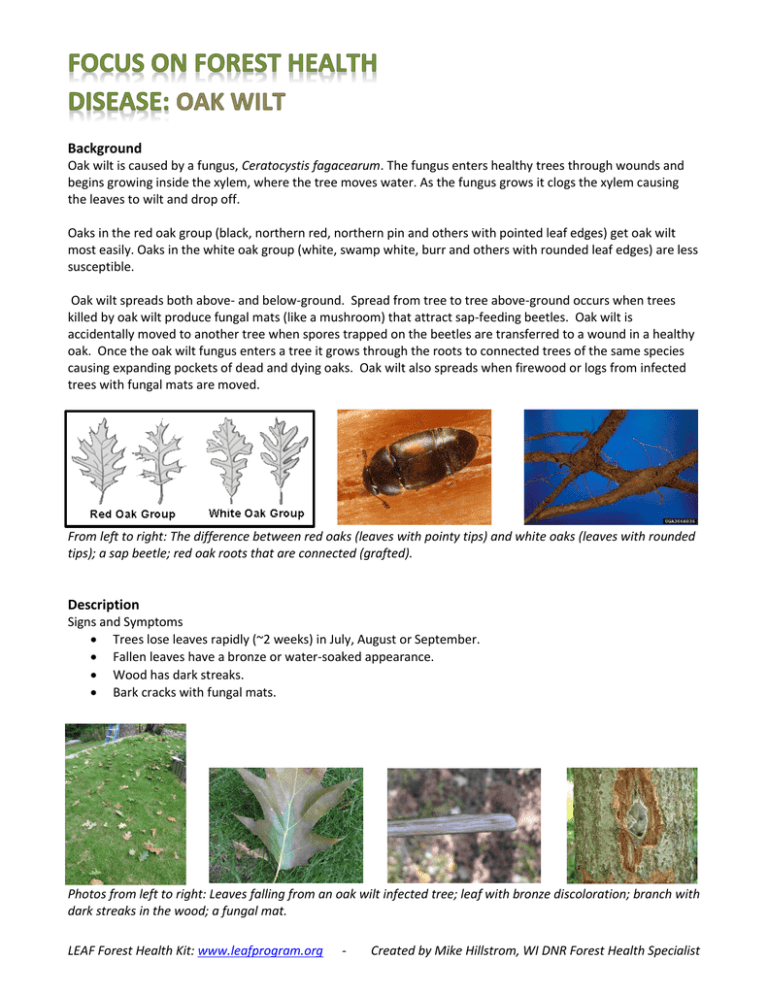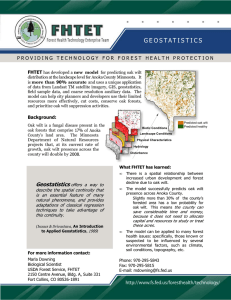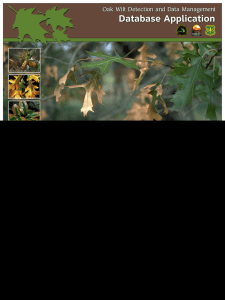Background
advertisement

Background Oak wilt is caused by a fungus, Ceratocystis fagacearum. The fungus enters healthy trees through wounds and begins growing inside the xylem, where the tree moves water. As the fungus grows it clogs the xylem causing the leaves to wilt and drop off. Oaks in the red oak group (black, northern red, northern pin and others with pointed leaf edges) get oak wilt most easily. Oaks in the white oak group (white, swamp white, burr and others with rounded leaf edges) are less susceptible. Oak wilt spreads both above- and below-ground. Spread from tree to tree above-ground occurs when trees killed by oak wilt produce fungal mats (like a mushroom) that attract sap-feeding beetles. Oak wilt is accidentally moved to another tree when spores trapped on the beetles are transferred to a wound in a healthy oak. Once the oak wilt fungus enters a tree it grows through the roots to connected trees of the same species causing expanding pockets of dead and dying oaks. Oak wilt also spreads when firewood or logs from infected trees with fungal mats are moved. From left to right: The difference between red oaks (leaves with pointy tips) and white oaks (leaves with rounded tips); a sap beetle; red oak roots that are connected (grafted). Description Signs and Symptoms Trees lose leaves rapidly (~2 weeks) in July, August or September. Fallen leaves have a bronze or water-soaked appearance. Wood has dark streaks. Bark cracks with fungal mats. Photos from left to right: Leaves falling from an oak wilt infected tree; leaf with bronze discoloration; branch with dark streaks in the wood; a fungal mat. LEAF Forest Health Kit: www.leafprogram.org - Created by Mike Hillstrom, WI DNR Forest Health Specialist Habitat and Current Distribution Oak wilt is a non-native disease that was officially discovered in Wisconsin in 1944 when the disease was first identified. Reports suggest it may have been present in Wisconsin as early as the late 1800s. Although it is unknown exactly how oak wilt made it to the WI, evidence suggests the disease may have come from Mexico or Central America. Oak wilt is widespread in southern Wisconsin but in much of northern Wisconsin it is still a new and uncommon disease. Current distribution maps can be found at dnr.wi.gov and search “oak wilt”. Impact and Management Ecological – Oak/hickory forests cover 25% of Wisconsin’s 16.6 million forested acres. Oaks are dominant forest tree species throughout much of the eastern U.S. They are also important shade and ornamental trees. Oaks trees and the acorns they produce are an important food source for mammals such as mice, deer and bears and also many birds. Dead oak trees can serve as excellent den trees for wildlife. Economic – Oaks are an important source of timber for lumber, furniture, veneer, paneling, and flooring. Its high fuel value makes oak good firewood. Social/recreational – Oak forests provide a wide variety of recreation opportunities for Wisconsin’s residents and the many tourists that visit. Oak forests provide many recreation options including biking, hiking, camping, wildlife viewing and beautiful fall colors. Oak trees in parks and our yards provide shade and help cool our homes in summer, slow rain water to prevent flooding and absorb air pollution. Oak wilt will continue to spread to oak trees of the same species with connected roots until disease spread is stopped. Getting rid of oak wilt is difficult and can be expensive so prevention is very important. Avoid pruning, cutting, or wounding oaks April through July. To take a very cautious approach, do not prune or otherwise wound oaks from April until October. If wounds occur from April through July use tree wound paint to help protect the tree. Managing oak wilt is difficult because the disease spread belowground through connected roots. If healthy oaks of the same species are near an infected tree, removing the infected tree will not control the spread. In fact, the fungus may move more quickly through the connected roots if infected trees are removed. The best control measure is to create a root graft barrier which disconnects the shared root systems between healthy and diseased trees. The most successful way of doing this is to physically cut roots with a vibratory or cable plow or trencher (see photo). Other methods, such as removing stumps, are being tested. After creating root graft barriers, diseased wood may be removed and used nearby for firewood or other projects. Trees that have died from oak wilt can still have the fungal mats so if this wood is moved, the fungal mats are moved and the disease may spread into new areas. Debark or cover firewood with a tarp with the edges buried until October the year after the tree died to prevent overland spread. Wood may also be used by sawmills or other wood businesses the coming winter. Trees may also be chipped and used for landscaping. For more information Oak wilt management: http://learningstore.uwex.edu/ Search “oak wilt” Oak wilt guide: http://dnr.wi.gov/ Search “oak wilt”. See the Prevention tab. http://www.treesearch.fs.fed.us/ Search “How to Identify, Prevent, and Control Oak Wilt” LEAF Forest Health Kit: www.leafprogram.org - Created by Mike Hillstrom, WI DNR Forest Health Specialist


